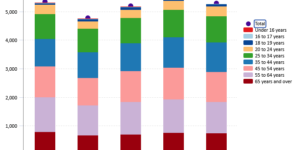 The outgoing director of the National Flood Insurance Program (NFIP) says the program is a “melting iceberg” that is incapable of properly managing its various players including the private insurance carriers that sell policies and handle claims.
The outgoing director of the National Flood Insurance Program (NFIP) says the program is a “melting iceberg” that is incapable of properly managing its various players including the private insurance carriers that sell policies and handle claims.
The government has 80 people overseeing a flood insurance network of hundreds of thousands of vendors and has lost control of how the program is administered, Brad Kieserman, deputy associate administrator within the Federal Emergency Management Agency (FEMA), which manages the NFIP, said in testimony yesterday before a House Financial Services Subcommittee on Housing and Insurance on Capitol Hill.
Kieserman said that the NFIP has become “increasingly disconnected from its real customers, flood survivors” and that the experiences of claimants following Hurricane Sandy have amplified its shortcomings.
He pointed to FEMA’s lack of oversight of the Write Your Own (WYO) program involving private insurers that delegate some of the work they do as a major part of the problem.
FEMA is currently in court along with private insurers and engineering firms involved in the flood program having to defend against thousands of complaints by Hurricane Sandy policyholders who allege their claims were unfairly and, in some cases, systematically denied, rigged or undervalued.
According to Kieserman, the defense cost for these cases could be more than the total defense costs for all NFIP events in the previous 20 years, including Katrina.
The agency has also offered to review all Sandy claims, even those not in litigation.
Sandy Lesson
“What we learned from Hurricane Sandy is that if the NFIP is going to remain as the first line of defense against flood damage for millions of policyholders, then we must change the way we deliver the program,” Kieserman told the subcommittee chaired by Rep. Blaine Luetkemeyer, (R-Missouri). He was the only person to testify.
“Hurricane Sandy showed us why the 47-year old NFIP is the proverbial melting iceberg: its product is stale and not well understood by consumers; some of the vital services the program delivers to disaster survivors have decreased in quality over time; the outdated business model we use to deliver the program makes increasingly little sense in the 21stCentury; and many property owners required by law to purchase flood insurance fail to do so,” he testified.
Kieserman’s melting iceberg analogy was inspired by a book on organizational change titled, “Our Iceberg is Melting,” in which he said the authors use a fable about a penguin colony that lived on the same iceberg for many years.
“When one curious bird discovers signs that the iceberg is melting, few of the other penguins want to listen to him. They are fine the way things are and do not want to change. But once a small group of penguins came to understand that their iceberg actually was melting, they created a sense of urgency to help others see the need for change and the importance of acting immediately,” he recounted.
The NFIP has 5.3 million policyholders in homes and small businesses across the country with $1.3 trillion of insurance coverage in force.
WYO Problem
According to the FEMA executive, a major part of the problem is the Write Your Own (WYO) program that was begun in 1983 as a cooperative effort between the government and private insurers that its designers hoped would increase sales and improve service. Under the WYO, private property/casualty insurance companies are allowed to write and service the standard NFIP flood policies in their own names, while the government retains responsibility for all losses. For their work, the private insurers receive an expense allowance. This allowance is currently 33 percent of every premium dollar.
Kieserman said this arrangement has meant that FEMA has become reliant upon a “broad-reaching network of actors” including the WYO carriers to manage the customer experience, as opposed to it being involved itself. This network, according to Kieserman, has grown to include 82 private insurers responsible for more than four million policies, a contractor that manages an additional one million policies, nine vendors that actually service 60 percent of the WYO policies, and nearly 245,000 insurance agents who sell flood policies.
There are also more than 400,000 real estate brokers, 53,000 title examiners, 30,00 loan officers and more than 300 adjuster firms with about 6,000 certified flood adjusters, plus an unknown number of structural engineers involved, according to Kieserman.
He said over the years the WYOs have in turn delegated much of the day-to-day work to subcontractors and vendors, yet some are not “properly overseeing the actions” of these subcontractors.
To oversee this vast network, FEMA has 80 employees or, as Kieserman said, “not even enough to dedicate one to each WYO” insurer.
This operating model means that FEMA has limited interaction with those who in turn interact with its customers, and lacks the “most basic actionable data” on which to judge performance and customer satisfaction, even though FEMA pays all the costs, and is ultimately accountable for paying claims fairly, he told lawmakers.
He said that two years after Sandy, the WYO companies and FEMA are now defendants in more than 2,000 court cases in which policyholders say they were unfairly denied payment.
Some of these cases allege fraud by engineering companies, adjusters and carriers, while others raise contract issues related to claims processing software and systemic underpayments.
FEMA is responsible for administering the NFIP and overseeing the WYOs and their services, but it failed to discover any problems, Kieserman said.
Senator Charles E. Schumer, D-N.Y., citing alleged “widespread fraud” and “unjust denials” in the handling of Superstorm Sandy claims, recently urged the FEMA to scrap the WYO model and “move forward to overhaul the process entirely.”
Rafael Lemaitre, FEMA spokesperson, told Insurance Journal that FEMA is reviewing the role private insurers play in the program.
Kieserman said FEMA is undertaking a forensic accounting of how the NFIP reimburses WYOs.
Latest Steps
He said FEMA has since taken steps to address the litigation around Sandy claims, review all claims for survivors even if not in litigation, and begin implementing reforms.
Also, in February, in what he said was an “unprecedented step,” FEMA, which generally defers to the WYOs in reaching settlement agreements, took control of this process and began reviewing hundreds of individual cases with a goal, he said, of providing every Sandy claimant in litigation with an offer by the end of August.
He said that as of May 31, about 25 percent of all cases in litigation had received offers.
FEMA has also offered to freshly review the claims of 142,00 policyholders who have not sued.
Kieserman said that FEMA can implement some reforms on its own. Among the steps it is taking are overhauling the claims process, increasing training for agents and adjusters, and auditing reimbursements to WYOs.
But he said additional reforms, “some of the boldest and most promising reform ideas” — which he did not outline — might require Congressional action.
He did, however, warn against doing nothing.
“We all have seen the signs the NFIP iceberg is melting. Still, some private sector actors involved in delivering the program are fine with the way things are and do not want to change. It is our role, now, to help everyone understand that the iceberg is actually melting and create the sense of urgency to help others see the need for change and the importance of acting immediately.”
*This story appeared previously in our sister publication Insurance Journal.




















 Moderating Premium Rates, Falling Yields: European Insurers Resilient
Moderating Premium Rates, Falling Yields: European Insurers Resilient  2025 Underwriting Profit and ‘Shop-a-Palooza’ Predicted for Auto Insurance
2025 Underwriting Profit and ‘Shop-a-Palooza’ Predicted for Auto Insurance  Loss-Free Property Cat Rates Fall 5-15% as Reinsurer Appetite Grows: Guy Carpenter
Loss-Free Property Cat Rates Fall 5-15% as Reinsurer Appetite Grows: Guy Carpenter  Surviving the ‘Silver Tsunami’: Closing the Talent, Skills Gap in Underwriting
Surviving the ‘Silver Tsunami’: Closing the Talent, Skills Gap in Underwriting 







